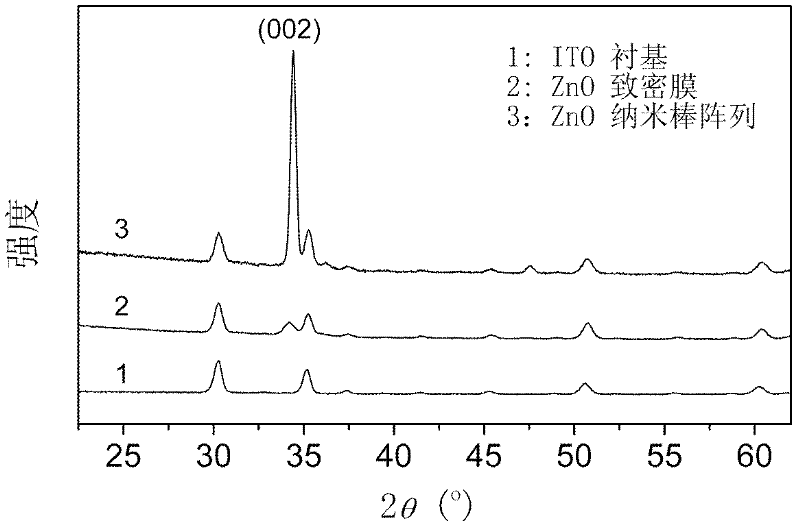Organic/inorganic hybrid solar cell and preparation method thereof
A solar cell, hybrid technology, applied in the fields of nanomaterials and energy, to achieve the effects of increasing open circuit voltage, performance, and short circuit current
- Summary
- Abstract
- Description
- Claims
- Application Information
AI Technical Summary
Problems solved by technology
Method used
Image
Examples
Embodiment 1
[0035] Example 1: Preparation of ZnO nanorod arrays.
[0036] (1-1) Preparation of ZnO dense film:
[0037] First, etch the ITO on the ITO conductive glass (ITO thickness is 100-120nm, ≤15Ω / □) to 12×4mm with concentrated hydrochloric acid and Zn powder 2 Thin strips; ultrasonically cleaned with acetone, isopropanol, and ultrapure water, and dried with dry nitrogen before use.
[0038] 0.16 g of zinc acetate [Zn(CH 3 COO) 2 2H 2 O] was dissolved in 1 g of water, and after complete dissolution, 4 ml of absolute ethanol was added, and then 100 μl of glacial acetic acid was added dropwise; the mixture was stirred at room temperature for 2 hours to obtain a colorless, clear and transparent solution. The above solution was spin-coated on ITO glass (2000 rpm, 60 seconds), and repeated four times to obtain a uniform film. Then, the zinc acetate film was aged in a container with a relative humidity of 52% (at room temperature) for 24 hours, and then calcined in a muffle furnace at...
Embodiment 2
[0043] Example 2: Preparation of ZnO-CdS heterogeneous core-shell nanorod arrays.
[0044] (2-1) Preparation of ZnO nanorod array: Same as Example 1.
[0045] (2-2) Preparation of ZnO-CdS heterogeneous core-shell nanorod arrays:
[0046] At room temperature, ZnO nanorod arrays were prepared at a concentration of 10 × 10 -3 mol / L of Cd(NO 3 ) 2 After soaking in the aqueous solution for 30 seconds, rinse with water for 30 seconds to remove a large amount of Cd(NO 3 ) 2 solution; then, this ZnO nanorod array was immediately placed in a 10×10 -3 mol / L Na 2 Soak in S aqueous solution for 30 seconds, and rinse with water for 30 seconds to remove unreacted Na 2 S solution; a SILAR process has been completed so far. The thickness of the CdS layer is controlled by the number (n) of SILAR processes. After repeating the SILAR process for n=30 and 50 times, a ZnO-CdS heterogeneous core-shell structure nanorod array (ie, ZnO-CdS-NA) was obtained.
[0047] (2-3) Characterization o...
Embodiment 3
[0049] Example 3: Preparation of polymer / heterogeneous core-shell nanorod array solar cells.
[0050] (3-1) Preparation of ZnO nanorod array: Same as Example 1.
[0051] (3-2) Preparation of ZnO-CdS heterogeneous core-shell structure nanorod array: same as Example 2.
[0052] (3-3) Preparation of MEH-PPV / ZnO-CdS-NA solar cells:
[0053] Using freshly distilled chlorobenzene as a solvent, prepare a MEH-PPV solution with a concentration of 10 mg / mL and stir it at room temperature for 24 hours. 100 microliters of MEH-PPV solution was uniformly dispersed on the ZnO-CdS-NA (n=30 or 50) layer, and then spin-coated (1500 rpm, 60 seconds) to deposit the polymer onto the ZnO-CdS-NA Above; after vacuum drying at 60°C for 12 hours to remove the solvent chlorobenzene, heat treatment at 150°C for 15 minutes in a nitrogen-protected glove box to allow the polymer to fully penetrate between the nanorods, and the polymer layer above the nanorods The thickness is 30-80nm.
[0054] Then, on th...
PUM
 Login to View More
Login to View More Abstract
Description
Claims
Application Information
 Login to View More
Login to View More - R&D
- Intellectual Property
- Life Sciences
- Materials
- Tech Scout
- Unparalleled Data Quality
- Higher Quality Content
- 60% Fewer Hallucinations
Browse by: Latest US Patents, China's latest patents, Technical Efficacy Thesaurus, Application Domain, Technology Topic, Popular Technical Reports.
© 2025 PatSnap. All rights reserved.Legal|Privacy policy|Modern Slavery Act Transparency Statement|Sitemap|About US| Contact US: help@patsnap.com



